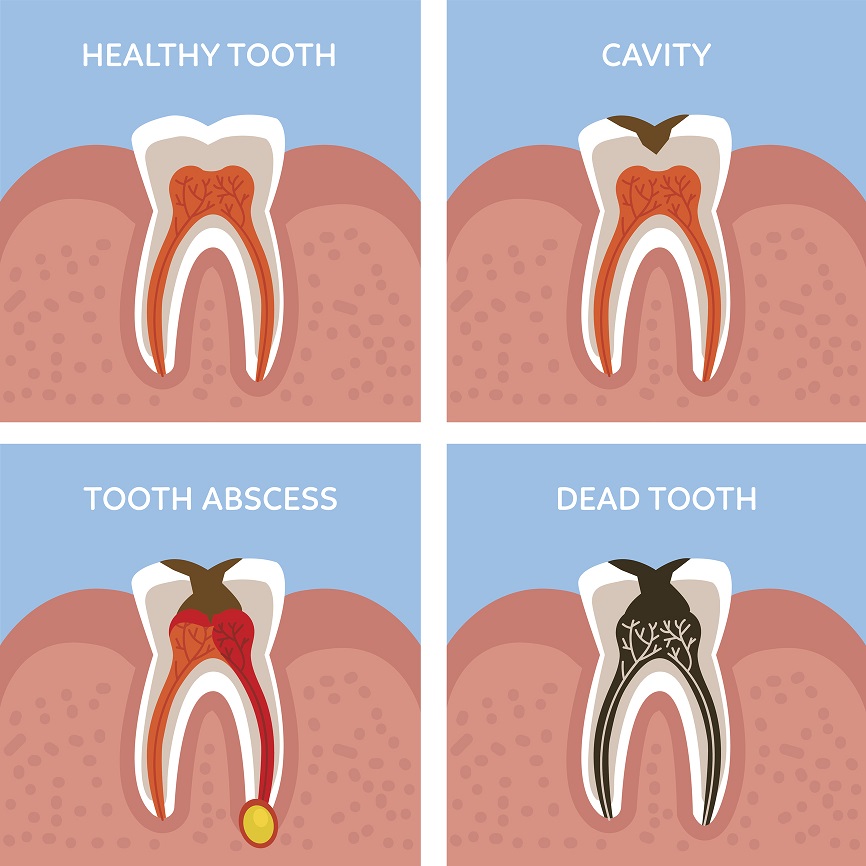
Can a Dead Tooth be Saved?
Have you ever noticed a tooth becoming painful or starting to change color? It could be a sign of a dying or dead tooth. Time is of the essence if you have a dead tooth, so learn what to do if you think you have one.
What is a dead tooth?
Teeth are living things. The pulp – nerves, blood vessels and connective tissue inside a tooth – keeps it alive. A dead tooth occurs when those tissues are damaged and the blood supply to the tooth is lost. It may be painful or may cause no symptoms at all. A dead or dying tooth should be treated quickly because it can become infected and have negative effects on the jaw, gums and other teeth.
“Dead tooth” is not always an accurate description. Although the pulp may have died, usually the tooth can be saved with a root canal.
What causes a tooth to die?
- Injury. Blood vessels inside the tooth may be damaged if you suffer trauma to your tooth from playing sports, falling on your face or other accidents.
- Tooth Decay. Poor dental hygiene and a diet high in sugar can cause cavities. If cavities are left untreated, bacteria can reach and infect the pulp, causing inflammation, infection and the death of cells within the pulp. Eventually, the blood supply is cut off and the pulp dies.
- A Large Filling. Even if decay hasn’t reached the pulp, the presence of a large filling can lead to pulp death. This can be caused by trauma to the tooth from long-term decay, filling the cavity or the transfer of heat and cold through the filling.
What are dead tooth symptoms?
- Tooth Discoloration. In a tooth injured by trauma, damage to the blood vessels can lead to pinkish discoloration and eventually a grayish-black color. If the tooth is discolored from decay, it may appear yellow, gray, light brown or black and become more discolored as it continues to decay.
- Tooth or Gum Pain. While some people won’t feel pain, others can experience mild to intense pain, primarily from the nerve endings between the outside of the tooth and the tooth socket.
- Tooth Sensitivity. A dying tooth may be overly sensitive to hot or cold.
- Additional Signs. A dead tooth can cause bad breath, a bad taste in the mouth or swelling around the gum line.
What are the treatment options?
- Root Canal. If the tooth is mostly intact, a root canal and a filling or crown may keep it functional. The root canal procedure removes the dead pulp and replaces it with a plastic-like material. Because a dead tooth can become brittle, the dentist may fit a crown over the tooth after the root canal treatment to strengthen and support it.
- Extraction. If a dead tooth is too damaged, it will likely need to be removed – another reason to seek treatment early on. You may be able to replace the tooth with an implant, denture, or bridge.
Can you prevent a dead tooth?
Accidents do happen so it may not be possible to prevent all injuries to teeth. However, you can take these measures to lower the risk of a dead tooth:
- Wear a mouth guard for sports and activities and a nighttime mouth guard if you grind your teeth in your sleep.
- Avoid using your teeth for the wrong purposes, like chewing ice or opening things.
- Maintain a healthy routine by brushing twice a day with fluoride toothpaste, flossing daily, eating a balanced diet and drinking plenty of water. Tooth decay – one of the leading causes of a dead tooth – is almost entirely preventable.
- Schedule routine dental visits so your dentist can detect and treat tooth decay early.
Leave a reply →
